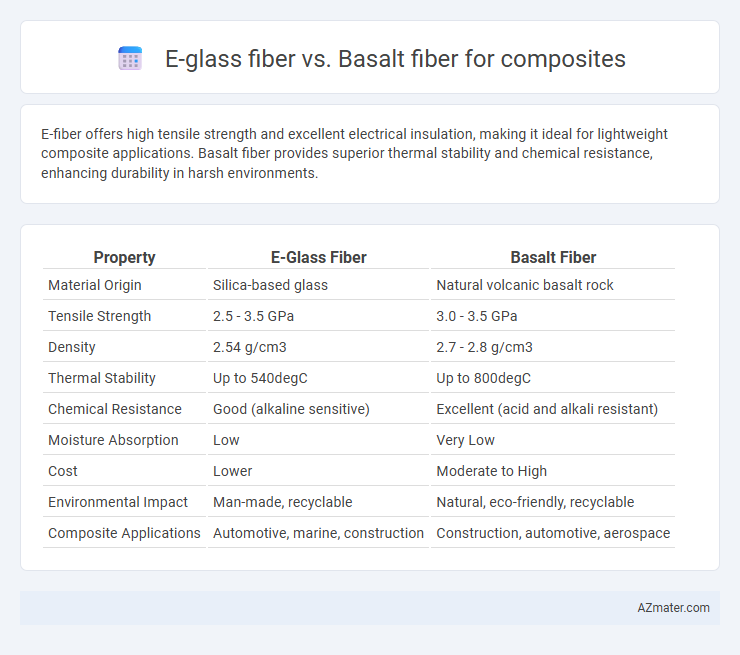E-fiber offers high tensile strength and excellent electrical insulation, making it ideal for lightweight composite applications. Basalt fiber provides superior thermal stability and chemical resistance, enhancing durability in harsh environments.
Table of Comparison
| Property | E-Glass Fiber | Basalt Fiber |
|---|---|---|
| Material Origin | Silica-based glass | Natural volcanic basalt rock |
| Tensile Strength | 2.5 - 3.5 GPa | 3.0 - 3.5 GPa |
| Density | 2.54 g/cm3 | 2.7 - 2.8 g/cm3 |
| Thermal Stability | Up to 540degC | Up to 800degC |
| Chemical Resistance | Good (alkaline sensitive) | Excellent (acid and alkali resistant) |
| Moisture Absorption | Low | Very Low |
| Cost | Lower | Moderate to High |
| Environmental Impact | Man-made, recyclable | Natural, eco-friendly, recyclable |
| Composite Applications | Automotive, marine, construction | Construction, automotive, aerospace |
Introduction to Composite Fibers
E-fiber and basalt fiber are both prominent reinforcement materials used in composite manufacturing, each offering distinct mechanical properties and environmental benefits. E-fiber, primarily composed of alumino-borosilicate glass, is widely favored for its high tensile strength, lightweight nature, and cost-effectiveness in applications such as aerospace and automotive components. Basalt fiber, derived from volcanic rock, provides superior chemical resistance, thermal stability, and eco-friendly attributes, making it ideal for construction and infrastructure composites requiring durability and sustainability.
Overview of E-Fiber and Basalt Fiber
E-glass fiber is widely used in composites due to its excellent electrical insulation, high tensile strength of approximately 3.5 GPa, and cost-effectiveness, making it ideal for lightweight structural applications. Basalt fiber, derived from volcanic rock, offers superior thermal stability up to 650degC and enhanced chemical resistance, with tensile strength ranging from 2.8 to 4.8 GPa, making it suitable for high-performance composite materials. Both fibers exhibit unique properties, where E-glass provides economic benefits and electrical insulation, while basalt fiber excels in mechanical durability and environmental resistance.
Material Composition and Structure
E-fiber, primarily composed of alumino-borosilicate glass, features a smooth, uniform microstructure that enhances its tensile strength and electrical insulation properties, making it ideal for composite reinforcement in lightweight applications. Basalt fiber originates from natural volcanic basalt rock, offering a complex polycrystalline structure with high chemical resistance, thermal stability, and excellent mechanical performance under harsh environmental conditions. The inherent differences in composition and crystalline structure between E-fiber and basalt fiber directly impact their compatibility, durability, and strength characteristics within composite materials.
Mechanical Properties Comparison
E-glass fiber exhibits high tensile strength ranging from 2.4 to 3.5 GPa and a moderate Young's modulus of approximately 70-85 GPa, making it widely used in lightweight composite applications. Basalt fiber provides superior mechanical properties with tensile strength between 2.8 to 4.8 GPa and a higher Young's modulus of about 89-100 GPa, offering enhanced stiffness and durability. The improved thermal stability and chemical resistance of basalt fiber composites make them favorable for demanding structural components compared to traditional E-glass fiber composites.
Thermal Performance and Stability
E-fiber composites exhibit excellent thermal insulation properties with a maximum service temperature around 120degC, making them suitable for applications requiring moderate thermal resistance. Basalt fiber composites demonstrate superior thermal stability, maintaining structural integrity at temperatures up to 700degC due to their volcanic rock origin and inherent crystalline structure. Their enhanced thermal conductivity and resistance to thermal degradation position basalt fibers as the preferred choice for high-temperature composite applications.
Durability and Environmental Resistance
E-fiber composites exhibit excellent electrical insulation and moderate durability but tend to degrade faster under UV exposure and alkaline environments compared to basalt fiber composites. Basalt fiber offers superior environmental resistance, including high resistance to moisture, chemicals, and temperature fluctuations, making it more durable in harsh conditions. The enhanced durability and environmental stability of basalt fiber composites make them ideal for infrastructure and marine applications where long-term performance is critical.
Cost Analysis and Availability
E-fiber composites typically offer lower initial material costs compared to basalt fiber, making them more economical for large-scale industrial applications. Basalt fiber, derived from volcanic rock, tends to have higher costs due to processing complexity but benefits from increasing demand and improved manufacturing techniques driving prices down. Availability of E-fiber is widespread with established supply chains, whereas basalt fiber availability is growing but still limited in certain regions, potentially affecting lead times and overall project costs.
Applications in Industries
E-fiber offers exceptional electrical insulation, lightweight properties, and high tensile strength, making it ideal for aerospace, automotive, and electronics industries where weight reduction and dielectric performance are crucial. Basalt fiber provides superior thermal resistance, chemical stability, and durability, favored in construction, automotive, and defense sectors for impact protection, fire resistance, and corrosion resistance. Both fibers enhance composite materials but suit different industrial applications based on environmental and mechanical requirements.
Sustainability and Environmental Impact
E-glass fiber exhibits higher energy consumption during production compared to basalt fiber, which is derived from natural volcanic rock and requires less processing, enhancing its sustainability profile. Basalt fiber offers superior biodegradability and lower carbon footprint, making it a more environmentally friendly option for composite materials. The durability and recyclability of basalt fiber composites contribute to reduced environmental impact throughout their lifecycle.
Conclusion: Choosing the Right Fiber for Composites
E-fiber offers excellent electrical insulation and cost-effectiveness, making it ideal for applications requiring lightweight and non-conductive materials in composite manufacturing. Basalt fiber provides superior mechanical strength, thermal resistance, and environmental durability, suitable for high-performance composites exposed to harsh conditions. Selecting the right fiber depends on specific performance requirements, with E-fiber preferred for electrical applications and basalt fiber favored for structural and thermal stability in composite designs.

Infographic: E-fiber vs Basalt fiber for Composite
 azmater.com
azmater.com